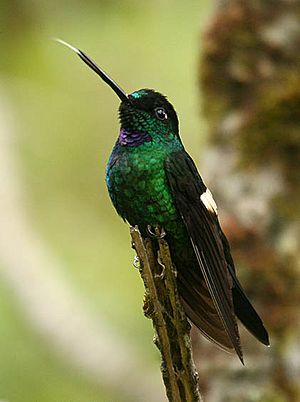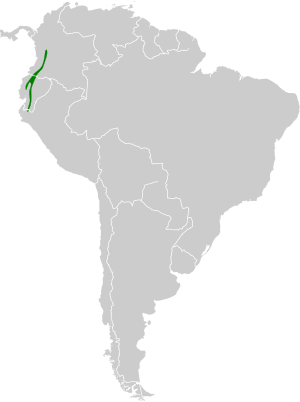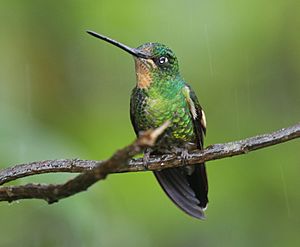Buff-winged starfrontlet facts for kids
Quick facts for kids Buff-winged starfrontlet |
|
|---|---|
 |
|
| Male in Yanacocha Reserve, Ecuador | |
| Conservation status | |
| Scientific classification | |
| Genus: |
Coeligena
|
| Species: |
lutetiae
|
 |
|
The buff-winged starfrontlet (Coeligena lutetiae) is a type of hummingbird known for its beautiful colors. It belongs to a group of hummingbirds called "brilliants." You can find this bird in the countries of Colombia, Ecuador, and Peru.
Contents
About the Buff-Winged Starfrontlet
How Scientists Classify This Bird
Scientists group living things together to understand them better. This is called taxonomy. The buff-winged starfrontlet and many other similar birds used to be in a different group called Helianthea. But since the mid-1900s, they have been placed in their current group, Coeligena.
Some bird experts, like the International Ornithological Committee (IOC), say there are two slightly different kinds (subspecies) of buff-winged starfrontlets:
- The main one, called C. l. lutetiae.
- Another one, called C. l. albimaculata.
However, other experts, like the Clements taxonomy, think there is only one kind of this bird.
What Does This Hummingbird Look Like?
The buff-winged starfrontlet is about 14 centimeters (5.5 inches) long. Male birds weigh around 6.9 to 7.2 grams, which is about the same as two pennies! Females are a bit lighter, at about 6.6 grams.
Both male and female birds have a long, black beak that curves slightly upwards. They also have a small white spot right behind their eye. Their tails are forked, like a "V" shape, but the male's tail has a deeper "V" than the female's.
Male Birds
The main type of male buff-winged starfrontlet has very dark, soft-looking upper parts. Its forehead shines with a bright green color. It has a purple patch on its throat, called a gorget, and the rest of its belly is dark green. Its wings are dark, but they have a big patch of cinnamon-buff color, which looks like a light orange-brown. The tail is a shiny black-bronze color.
Female Birds
Female birds of the main type have shiny dark green upper parts. Their throat is a cinnamon-buff color. The rest of their belly is golden-green with light edges on the feathers. They have the same cinnamon-buff patch on their wings as the males, but their tail is a bronzy-green.
Differences in Subspecies
The males of the C. l. albimaculata subspecies have wing patches that are almost white, instead of cinnamon-buff. Otherwise, they look similar to the main type. The females of this subspecies have a lighter throat color and their golden-green belly feathers are not as shiny.
Where Do They Live?
The main type of buff-winged starfrontlet lives in the Andes mountains. You can find them from central Colombia, south through Ecuador, and into the very northern part of Peru. The C. l. albimaculata subspecies is found only in northwestern Ecuador.
These birds like to live in cloudforests, which are forests often covered in clouds. They also live in "elfin forests," which are small, dense forests, and at the lower edges of páramo, which are high-altitude grasslands. They usually live at elevations from 2,600 to 4,800 meters (about 8,500 to 15,700 feet) above sea level. They are most commonly found around 3,000 meters (about 9,800 feet) high.
How Buff-Winged Starfrontlets Behave
Bird Movements
Buff-winged starfrontlets usually stay in one area. They don't travel far. However, they might move a little bit to find flowering plants when they are blooming.
What and How They Eat
These hummingbirds mostly eat nectar from flowers. They often use a method called "trap-lining." This means they visit a regular path of flowers, going from one to another. They also protect patches of flowers from other birds. They usually look for food low down, at the edges of forests. They often hold onto flowers while they feed, but they can also hover in the air. Besides nectar, they also catch small insects by picking them off leaves or by catching them in the air.
How They Raise Their Young
In Colombia, buff-winged starfrontlets usually breed in August and September. Scientists don't know much about their breeding season in other places. The female bird builds a cup-shaped nest in the fork of a tree branch. The nest is usually about 2 to 4 meters (6.5 to 13 feet) above the ground. The female sits on her two eggs for 15 to 17 days to keep them warm until they hatch. Scientists are still learning how long it takes for the baby birds to be ready to fly.
Bird Sounds
The buff-winged starfrontlet makes a "thin, wiry chatter with rattles." You might hear this sound when two birds are arguing over their territory. When they are feeding, they often repeat a special "unk" sound that sounds a bit like it's coming from their nose.
Protecting the Buff-Winged Starfrontlet
The IUCN (International Union for Conservation of Nature) says the buff-winged starfrontlet is a species of "Least Concern." This means they are not in immediate danger of disappearing. However, we don't know exactly how many of these birds there are, and their numbers are thought to be going down.
Even though they live in a fairly large area, their habitat (the places they live) is broken up into small patches. These areas are also being threatened by deforestation, which is when forests are cut down. These birds probably won't live in places like gardens that humans have created.
See also
 In Spanish: Inca alihabano para niños
In Spanish: Inca alihabano para niños



